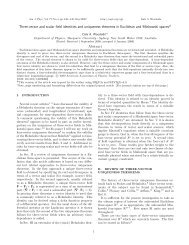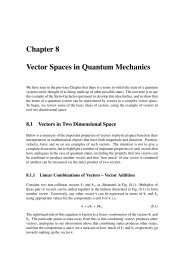Electrostatic Fields in Matter
Electrostatic Fields in Matter
Electrostatic Fields in Matter
Create successful ePaper yourself
Turn your PDF publications into a flip-book with our unique Google optimized e-Paper software.
6 Bound Charges• Detailed derivation: Griffiths section 4.2.1, page 166 (non-exam<strong>in</strong>able)• Simpler derivation: Griffiths section 4.2.2, page 170.The follow<strong>in</strong>g is similar to Griffith’s simpler derivation.When a dielectric is polarised, the movement of charge createsregions <strong>in</strong> the dielectric which can have a net charge. We will deriveexpressions for the densities of these bound charges.The electric field produced by a polarised dielectric is calculatedsimply by calculat<strong>in</strong>g the field due to the bound charges.6.1 Surface Bound Charge DensityThe diagram shows a small area da at the surface of a polariseddielectric. This area is represented by a vector da, ⃗ normal to thesurface. The polarisation at this po<strong>in</strong>t is at some angle θ to thesurface normal.In each atom the positive charges have been displaced by d ⃗ relativeto the negative, so ⃗p = Qd ⃗ (and remember P ⃗ = n⃗p).PθdatThe charges move <strong>in</strong> the direction of ⃗ P . At the surface this leavesa layer of uncompensated charge, with a thickness t = d cos θ.6
















